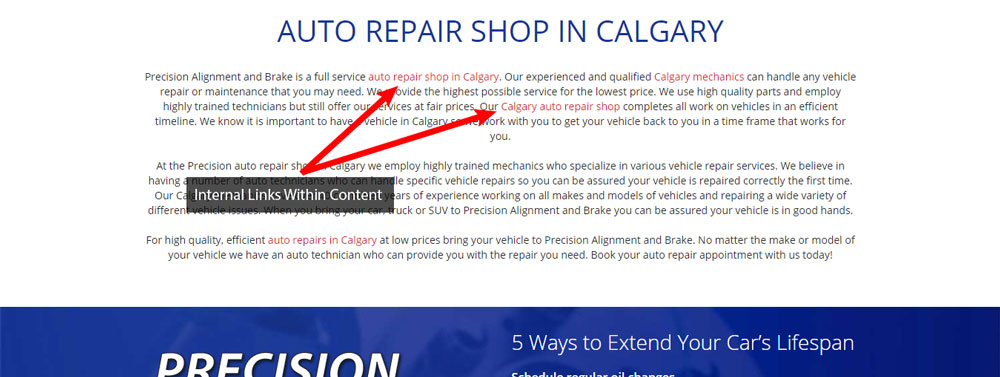Internal linking is used on all websites and is essential for navigating a website’s content. Internal links are links located on a website that link to another page on that same website. Internal links are most commonly used for creating a website’s navigation or menu or located within the sites content. Internal links are essential in allowing users to access content located throughout your website and create a hierarchy for your content. However internal links also play a major role in SEO and having a proper internal linking structure can affect how your website ranks on search engines.

Where Should Internal Links Be Included on a Website?
As mentioned above internal links are most commonly found in a website’s main navigation, but this is not the only place for them. Internal Linking best practice is to also include internal links within your website’s content. You have probably seen it on a number of sites you’ve visited in the past, you’ll be reading some content on the site and then you come across a phrase or a few words that are linked to another page. This is a great internal linking strategy as linking these pieces of content to pages with relevant content allows users to delve deeper into your site and helps search engines find additional pages for indexing.
Search Engine Spiders Need Internal Links to Find Your Content
Search engine spiders like the Google crawlbot need a proper internal linking structure in order to find all the content on your website. Search engine spiders use internal links to move from one page to another and index that content. When a crawlbot enters a site it will use all the links on the page it enters from to move to additional content on your site, and subsequently index that content. If you have pages on your website that do not have any internal links pointing to them Search engines will have a harder time finding and indexing that content.
This means you could have quality content not even being recognized by search engines. It is important to audit your site and make sure your internal linking has a proper hierarchy and all of the pages on your site can be reached through internal links.
What is Anchor Text?
Anchor text is the phrases or words you attach your internal links to. The anchor text is the words that users click on to be taken to relevant content. The anchor text you decide to use for your internal links matters. You want to make sure that your anchor text is relevant to the content you are linking to. You don’t want to include a link to a page about hammers and use the anchor text tools. You want your anchor text to be specific to the actual content you’re directing a user to.
Another important thing to know about anchor text is that it is important to vary it throughout your site. You do not want all your internal links to have the anchor text “click here.” You want your anchor text to be descriptive as to what content it is linking to. Try to use different phrases and words for your anchor text to help with your site SEO.
Use Anchor Text for Your Internal Links
It is best practice to use anchor text for your internal links as opposed to using image links. Anchor text can be identified by search engines and make it easier for them to understand what the content in the linked page may contain. Using images for internal links can work as long as they are not your primary source of internal linking and have the proper alt tags.
Link Deeper Within Your Site
It is important to make sure that your internal links are taking users deeper within your website. You do not need an internal link in your content that takes the user back to the page they just came from. You want to take users deeper within your website and maintain a linking hierarchy that goes from the top down. For example you do not need a link pointing to your about us page in all of your content. About Us page links are regularly found in a website’s main navigation and since it is a top level page this is all the internal linking it requires. Use internal links to point users and search engines to content relevant to the page they are currently on. This will help with easier navigation and providing page authority to the content you are linking to.
Don’t Use Too Many Internal Links
When implementing an internal linking strategy it is important to not go overboard on the number of internal links you implement. Google makes this clear with their instructions “keep the links on a given page to a reasonable number.” It is hard to know exactly what Google means by reasonable. Does this mean under 50 links, under 100 links or under 500 links? No one knows the exact number but an easy rule to follow is to only incorporate internal links where they make sense. If there is a piece of content that mentions relevant content that you have on another page then include an internal link. Don’t just throw in an internal link for the sake of having more internal links.
We Can Help
Are you unsure on how to implement an internal linking strategy on your website? Luckily the SEO experts at Konstruct Interactive are ready to help you. We have experienced SEO professionals who have implemented internal linking strategies on all types of websites for a wide variety of business types. We are ready and waiting to help you with internal linking and any other SEO service your business may require. If you having any questions, information requests or are interested in our services please contact us at 587-316-1681.
Need help with B2B SEO?
Learn more about Konstruct's B2B SEO Services
More B2B SEO Resources
- How to Select High-Impact Keywords for B2B SEO
- B2B SEO Statistics To Help You Justify Your Marketing Spend
- How to Create an SEO-Friendly Site Structure
- B2B eCommerce SEO: How to Optimize Your eCommerce Site to Attract B2B Buyers
- The Ultimate SEO Tools List (30+ Free & Paid Tools You Need!)
- SEO Competitor Analysis: What is it & How to Benefit From it
- How to do Keyword Research: A Step By Step Guide With Tools & Tips
- The Ultimate Hyperlocal SEO Guide for Local Businesses
- The Top 8 Key SEO Metrics You Need to Start Tracking Today
- Google Analytics 4: What Is It & Why You Should Be Using It




